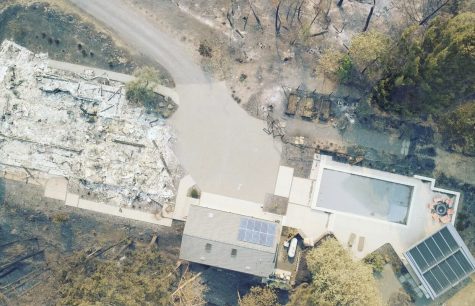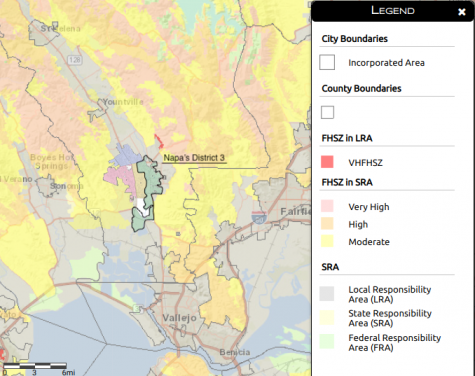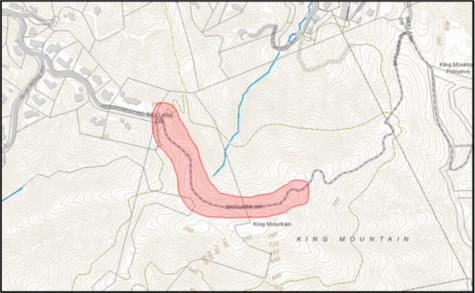Wildfires have always been the monster under the bed for Californians, sneaking out from the yellowed brush when the weather is warm and the drought is intolerable. And while it has always been present, this monster has been particularly cruel during the pandemic, as five of California’s largest wildfires have swept the Golden State in the past year and a half.
As a longtime California resident, Redwood Living Earth and Chemistry teacher, Mark Summary struggles to remain optimistic when better years are no where in sight.

“Fire seasons are getting longer [in California],” Summary said. “Warmer temperatures mean that you’re more likely to have extremes, and you’re more likely to have drier vegetation and fires in places that historically did not have devastating wildfires.”
The town of Healdsburg in Sonoma County, where Redwood sophomore Evie Giordano had once enjoyed spending time at her family’s second home, is one such area that had comparatively low fire risk only a decade ago. This all changed however, when years of evacuation warnings turned into the evacuation orders for the Sonoma–Lake–Napa Unit Lightning Complex Fires (LNU Lightning Complex Fires) which consumed some 1,491 structures, including the Giordano family’s home, to just chimneys and sidewalk.
“We found out on Aug. 24 [in 2020] and school was starting the next week,” Giordano said, “Everything completely burned to the ground. Our home, all the trees in the surrounding area, all my childhood belongings … gone.”

However, for recovering fire victims hoping to start a new life, there may be some direction amongst the chaos. The Department of Homeland Security (DHS) has recently raised significant funding for the improved Fiscal Year 2020 Fire Prevention and Safety (FP&S) Grant Program which has dedicated itself to “provid[ing] critically needed resources to carry out fire prevention education and training, fire code enforcement, fire [and] arson investigation, firefighter safety and health programming, prevention efforts, and research and development.” The DHS has additionally reserved an unheard of $710 million to Assistance to Firefighter and Adequate Fire and Emergency Response Grants.
According to Napa District supervisor Diane Dillon, the county has received significant state and federal grants from the DHS. And, after the roaring Atlas, Tubbs and Nuns fires of 2017 surrounded the county, fire safety and evacuation procedures have become a priority.
“I grew up in Napa and remember a huge fire in 1981, but to see it happen to this county in 2017, in 2018 and last year — it was a wake up call that signaled something different,” Dillon said, which Napa county has since learned to act on.

“Our sheriff came up with the idea of using high-low sirens which, while [commonly] used in Europe, are not [historically] used in the United States.” Dillon said.
In the U.K., high-low sirens are recognized by their unique two-tone frequency and are used to alert residents of the need to evacuate. In 2018, Napa became the first county in the United States to utilize high-low sirens; now found throughout California. According to Dillon, these sirens are particularly useful in areas with poor cell phone reception, where National Alert Systems, such as Nixel, often fail to work.
Another sheriff-born idea was the distribution of evacuation tags, which evacuees put up on their front door or gate to inform local officials of their leave. Also implemented in 2018, these tags were used by Napa residents when evacuation warnings were given during the 2020 LNU Lightning Complex fire.
In recent years, Napa County has also taken up extensive fuel mitigation projects. Fuel mitigation is the practice of manually clearing debris and vegetation which makes wildfires easier to manage. While the process is more labor intensive and expensive than procedures like prescribed burnings, it takes less time to be approved by institutions such as the Bay Area Air Quality Management Board (BAAQMB). According to Dillon, The BAAQMB has always been strict, and before approved firefighters can even begin the process, there must be near-perfect wind conditions, low temperatures and sufficient moisture content outside. Additionally, even if the board approves such measures, the state of California is divided into Federal Fire Responsibility Areas (FRAs), Local Responsibility Areas (LRAs) and State Responsibility Areas (SRAs), which further slows and complicates the procedure.

While fire management projects still require applications and procedures because of the National Environmental Policy Act (NEPA) and stricter California Environmental Quality Act (CEQA), it is important that at-risk counties like Napa take action now and year-round, making fire management the obvious, if not only choice.
Taking after Napa, the Central Marin County Sheriff’s Office of Emergency Services (OES) has now integrated high-low sirens and evacuation tags. As for fire management projects, the Marin Wildfire Prevention Authority has allotted $774,000 to wildfire prevention and mitigation projects in counties near Marin. This is a crucial step to ensure the greater safety and confidence of at-risk communities of the Bay Area, in addition to the lives and well-being of recovering families like the Giordanos.
“When you hear about it on the news, [wildfires are] definitely one of those things where you think, ‘Oh, people’s houses are burning down; ‘That’s so crazy,’” Giordano said, “You never think it’s going to happen to you … until it’s too late to prepare.”







